Betting on sports is inalienable from knowing how to read sports odds. Understanding how betting odds are calculated is essential for both players and operators. Bookmakers can evaluate odds provided by their data suppliers and better cater for the needs of their players, while players can clearly interpret the outcome of their bet.
At first glance, the table of events may appear complicated and the odds unclear, but that is a misconception. Our hands-on tutorial will guide you through real examples to understand how sports betting odds work, what types of odds are available and how they differ from each other.
Understanding Betting Odds
Before we talk about odds, it is important to introduce the concept of ‘probability’; it is on probability that the bookmaker's odds are built. Probability in sports betting is the possibility of one of the outcomes to occur.
In order to calculate the probability, an in-depth analysis of player, team, opponent stats and so on is performed. If the bookmaker does not calculate the probability themselves, choosing a reliable sports data provider is essential.
Now that we have established the definition of probability, let's get back to the odds. Betting odds are the probability of a particular event outcome expressed in monetary terms, including the operator's margin. The term 'event' in this context refers to sporting events (matches, games, etc.) on which bettors place their stakes.
Essentially, odds are a measure of how likely something is to happen. The simplest case of probability involves a 50/50 chance of winning a coin toss - no more options, just heads or tails all the time. To convert this percentage probability into decimal odds, for example, we need to divide 100% by the probability of the outcome, which in our coin case is 100% / 50% = 2.0
No matter how the odds are written, the value is always the same and indicates how much the bettor will get if their outcome wins. The different display of odds is only due to the habit of players in certain regions to perceive betting odds in a certain way. We will look at each type of odds in detail below.
The sports disciplines available for betting depend directly on the location. Each country has its specifics which are mainly related to its culture and history. The UK favours horse racing, while India is more likely to bet on cricket. Football, hockey, table tennis, volleyball, and the relatively new but up-and-coming eSports are invariably the top most popular sports for all regions.
Let’s explore how the odds calculations work and what factors should be considered.
How Do Betting Odds Work
Two main factors determine a bookmaker's betting odds: the probability of the event and the margin. For the first factor, everything is clear: the odds inversely relate to probability. In other words, the greater the chance of an outcome, the lower the odds.
Sporting events usually distinguish between a favourite (referring to a leading, popular team) and an underdog (referring to the less popular opponent). When the favourite meets the underdog, the odds are always higher for the underdog and lower for the favourite.
As the event progresses, the odds change as well. If the likelihood of the event increases, bookmakers will reduce the odds. Anything can be a factor in the odds: bad weather on a game day, an injury of one of the most valuable players, a change of coach, etc. Players can influence bets more than anything else: if during a game or match, players confidently pick one outcome and ignore another, the bookmaker is likely to lower the odds on a popular outcome and raise the odds on a less popular one.
Let's look at an example from eSports. Vitality plays against Astralis; the odds of Astralis winning are 2.57, and the odds of Vitality winning are 1.47.
| The winner | 1. Vitality wins Astralis | 2. Astralis wins Vitality |
|---|---|---|
| 1. Vitality 2. Astralis |
1.47 | 2.57 |
Vitality is the favourite, as they won Astralis at the Majors 2021, the leading CS:GO competition. Bookmakers will adjust the odds if, for example, new details are revealed or the Astralis team gets their revenge and wins the map.
A bookmaker's margin is another factor that influences odds count. The margin is the bookmaker's net revenue, which does not depend on whether the player wins or loses. The sportsbook's profit percentage is already included in all odds for each outcome and event.
To go back to our coin example, heads and tails have odds of 2.00 without margin.If the bookmaker decides to put in, for example, 5% margin, the final odds would look like this: 2 / 1.05 = 1.9.
Below is a simplified margin calculation formula. To calculate more outcomes (for example, three: 1st team wins, 2nd team wins, or a draw), just add the 3rd summand terms in brackets.
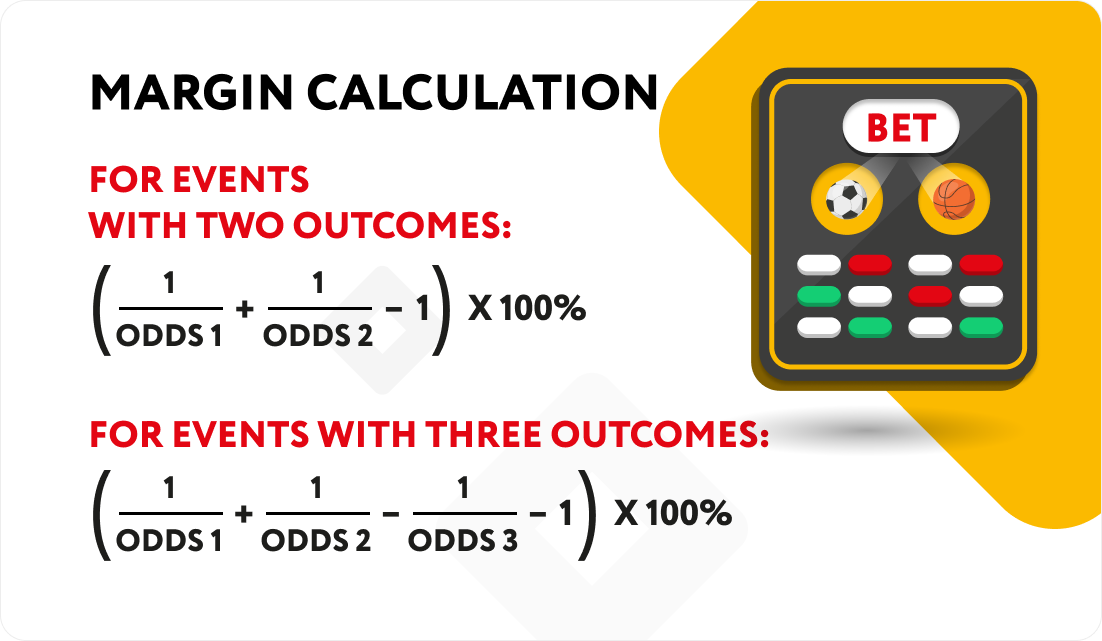
In the case of the eSports example above, the bookmaker's margin would be 6.94%.
Types of Betting Odds
No matter how the odds are written, they do not affect the winnings. However, many countries have their own traditions on defining and displaying odds
British Odds
The undisputed birthplace of the first sportsbooks was the UK, so it makes sense to start there.
British odds, also known as fractional or ratio odds, refer to a system in which the odds are displayed as fractions. The left or top side of the fraction (the numerator) sets winning units, and the right or bottom side (the denominator) specifies betting units that need to be placed to get the winnings.
For example, let's look at the Bayern-Stuttgart football match:
| The winner | 1. Bayern wins Stuttgart | 2. Stuttgart wins Bayern | Draw |
|---|---|---|---|
| 1. FC Bayern Munich 2. VfB Stuttgart |
9/31 | 62/7 | 26/5 |
The betting odds can tell us who is the favourite and who is the underdog in this encounter: the odds of Stuttgart winning are much higher, which means they have a lower chance of winning, according to the analysts. Bayern has lower odds, which means they have a higher chance of winning the match.
Let's read the odds and clarify what the numerator and the denominator mean in each case:
- 9/31 - for every 31 GBP bet, the player receives 9 net winning GBP.
- 62/7 - for every 7 GBP bet, the player receives 62 net winning GBP.
- 26/5 - for every 5 GBP bet, the player receives 26 net winning GBP.
If the outcome occurs in the case of a 100 GBP bet on the draw, bettors will receive 100x(26/5) = 520 GBP net win + a stake of 100 GBP back. The total winnings will be 620 GBP.
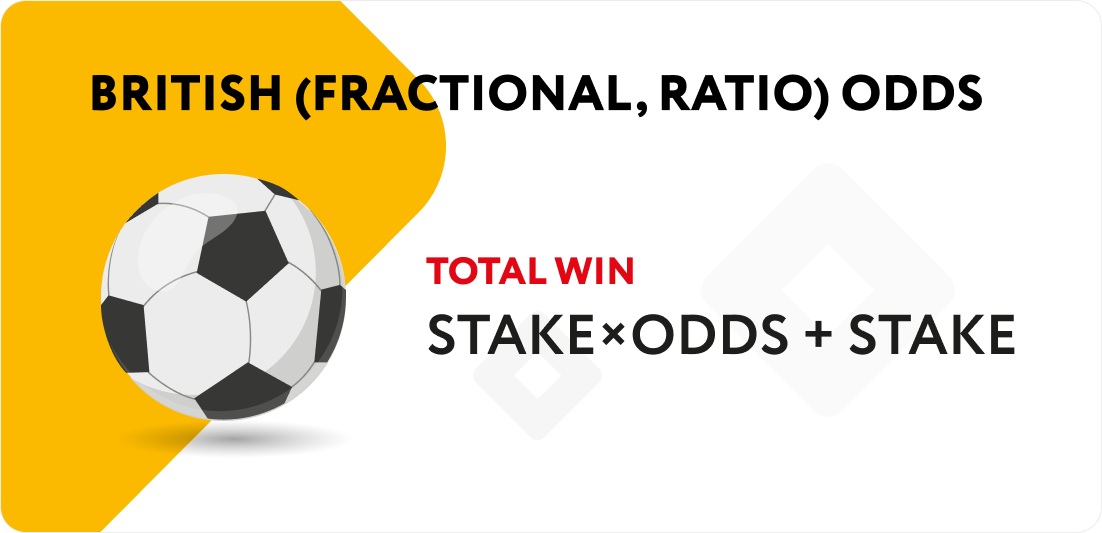
American Odds
This type of betting odds is quite common in the United States. American (moneyline) odds work in the same way as any bookmaker's odds: they reflect the probability of the outcome and represent the potential winnings.
With a glance at the moneyline, bettors can quickly see who is the favourite and who is the underdog. The leader’s odds are written with a ’-’, those of the underdog with a ‘+’.
The "positive" odds mean a potential winning unit for every 100 USD bet. The "negative" ratio works oppositely: it shows how much a player has to bet to win 100 USD.
For example, let's consider hockey. For the match between Vegas Golden Knights and Boston Bruins, a bookmaker offers the following odds (not including a draw):
| The winner | 1. Vegas wins Boston | 2. Boston wins Vegas |
|---|---|---|
| 1. Vegas Golden Knights 2. Boston Bruins |
+115 | -140 |
There are two options:
- If the player bets 100 USD on the first outcome and it succeeds, the total winnings will be 215 USD (115 USD as net winnings + the original stake of 100 USD)
- If the player predicts Boston's win and bets 140 USD on it, their potential profit is 100 USD + their initial stake of 140 USD, which equals 240 USD.
Here is a typical formula for American odds.
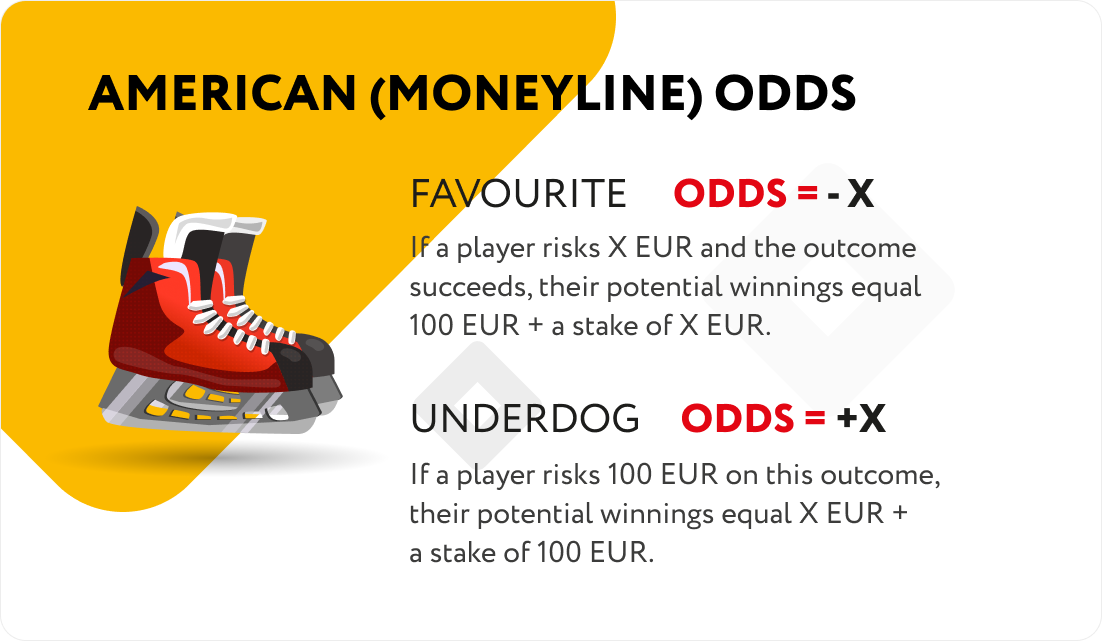
European Odds
The European odds (decimal odds) emerged when the betting industry spread from the UK to neighbouring France, spreading across Western Europe at a breakneck pace. Even though British sportsbooks remained very popular, the new gambling establishments were good competition.
Many people found the British odds system too complex. As a result, the European, or decimal, odds system emerged. Traditionally, European odds are written in decimal form: 6.1; 4.7, etc.
Here is an example of darts: Ricky Evans vs Nitin Kumar.
| The winner | 1. Evans wins Kumar | 2. Kumar wins Evans |
|---|---|---|
| 1. Ricky Evans 2. Nitin Kumar |
1.06 | 8.6 |
The player betting 100 EUR on the clear favourite Evans will win 100 EUR x 1.06 = 106 EUR, where net winnings are 6 EUR.
The player may risk 100 EUR on Kumar's win, and, should the outcome occur, the player will receive 100 EUR x 8.6 = 860 EUR, where 760 EUR is the net winnings.
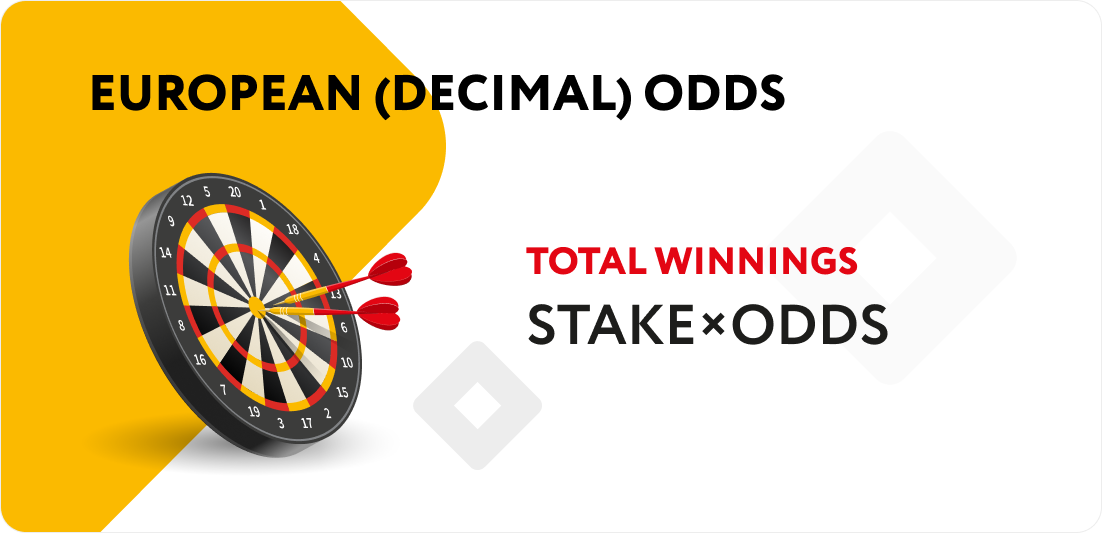
Hong Kong Odds
As the name suggests, this type of betting odds is most popular in Hong Kong. However, many bookmakers provide it in other countries since players easily read this type of odds.
How does Hong Kong odds work? It is similar to the previous European format because it is shown in decimal form. A crucial difference: Hong Kong odds show net winnings (rather than the total amount) the player can expect if the bet wins.
Here's a tennis example: Elsa Jacquemot meets Caroline Garcia.
| The winner | 1. Jacquemot wins Garcia | 2. Garcia wins Jacquemot |
|---|---|---|
| 1. Elsa Jacquemot 2. Caroline Garcia |
1.48 | 1.53 |
If the player decides to bet 100 HKD on the winnings of the 1st tennis player, then their potential winnings would be 100 HKD x 1.48 = 148 HKD, for a total of 248 HKD.
In the case of a bet of 100 HKD on the opponent's winnings, if the outcome occurs, the net profit is 100 HKD x 1.53 = 152 HKD, making the total sum together with the bet 252 HKD.
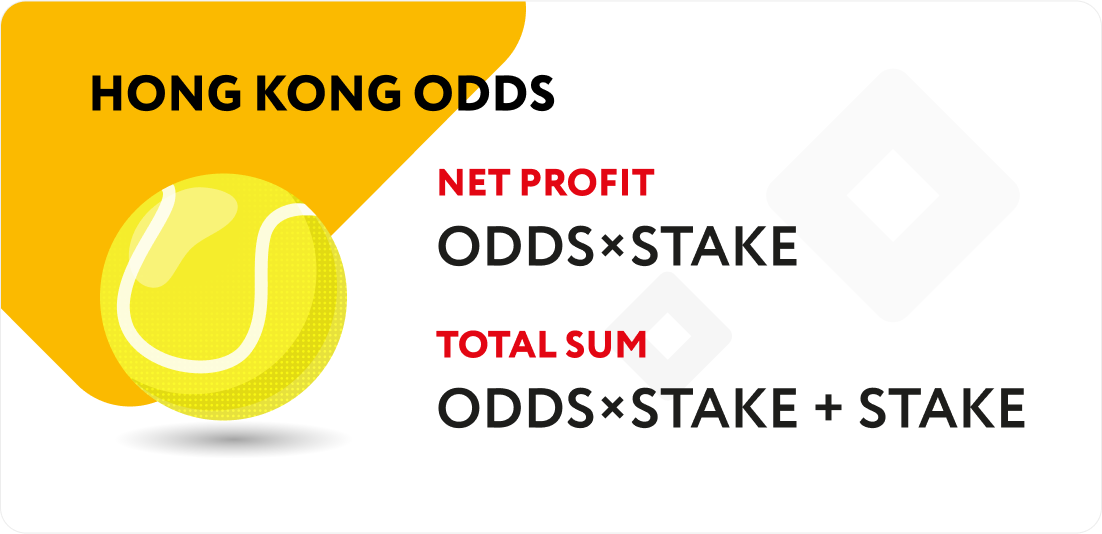
Indonesian Odds
The Indonesian odds look much the same as the standard European decimal odds. But it draws inspiration from the American odds format, as it has a positive (‘+’) or negative (‘-’) value.
If the odd is shown with a ‘+’, it shows the net profit if a player bets 1 USD. The same applies to American odds, but the only difference is that Americans determine the yield from 100 USD and Indonesians from 1 USD.
If the line shows a ‘-’ sign, the player understands how much they have to bet to profit 1 USD.
Here is a UFC example for better understanding: Sijara Jihan Eubanks and Melissa Gatto.
| The winner | 1. Eubanks wins Gatto | 2. Gatto wins Eubanks |
|---|---|---|
| 1. Sijara Jihan Eubanks 2. Melissa Gatto |
-1.5 | +1.1 |
For example, a bettor bets 100 IDR on the 1st MMA fighter. If the bet wins, they will make a net profit of -(100 IDR / (-1.5)) = 67 IDR. The total payoff would be 67 IDR + 100 IDR = 167 IDR. If the bettor chooses the 2nd outcome and risks 100 IDR, they may receive 100 IDR x 1.1= 110 IDR net profit with total winnings of 110 IDR + 100 IDR = 210 IDR.
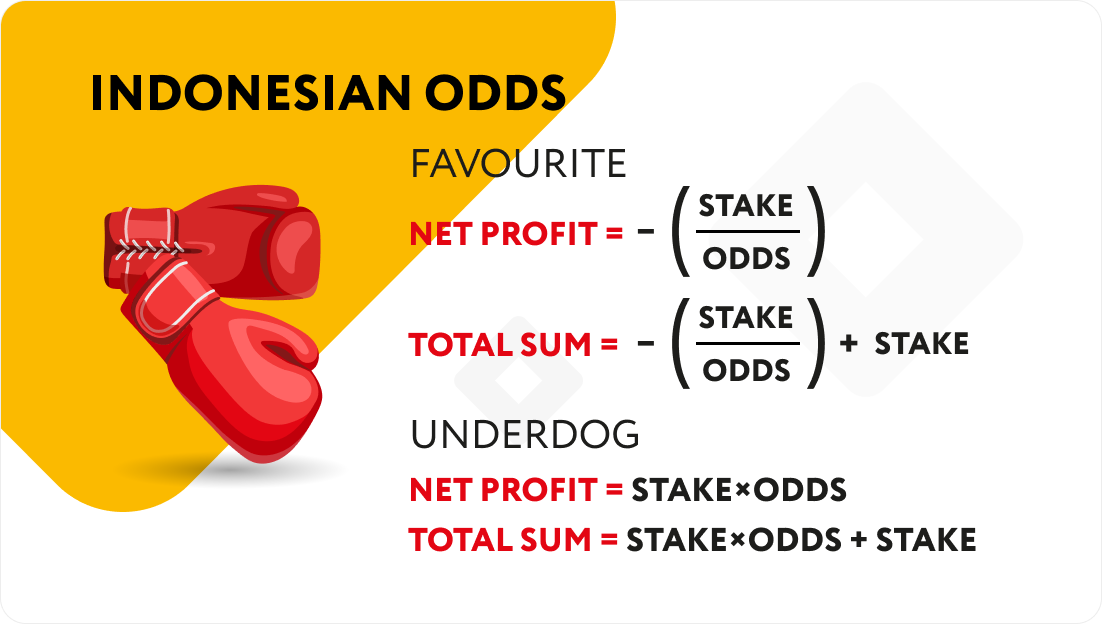
Malaysian Odds
Unlike the Indonesian system, the Malaysian odds system works as a mirror of the American model. Bookmakers define the odds with a minus or plus value and present it as a decimal fraction (for example, -0.29 or +1.0). The value with a negative sign indicates how many monetary units should be bet to win 1 MYR.
Last but not least, an example from basketball: the game between the Orlando Magic and the Atlanta Hawks (excluding a draw).
| The winner | 1. Magic wins Hawks | 2. Hawks wins Magic |
|---|---|---|
| 1. Orlando Magic 2. Atlanta Hawks |
-0.35 | 0.36 |
If players bet 100 MYR on the Orlando Magic and the team lives up to expectations, the net win will be -(100 MYR / (-0.35)) = 285.7 MYR.
If betting the same amount on an opponent's victory, and the prediction comes true, the net winnings will be 100 MYR x 0.36 = 36 MYR.
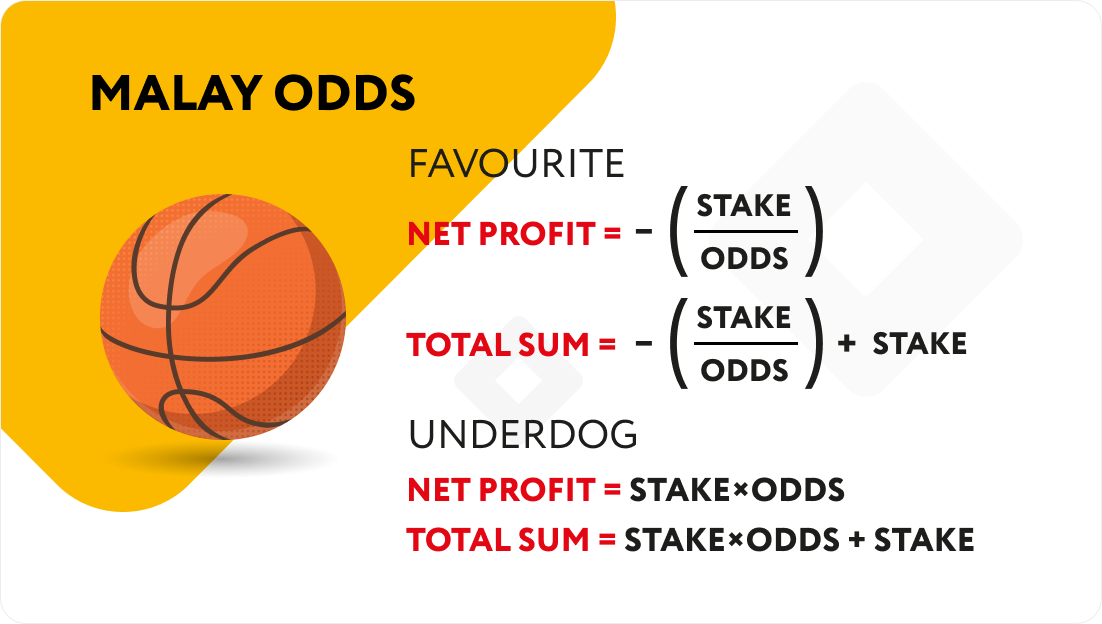
Sports Odds: Quick Rules to Remember
Once a solid understanding of how betting odds work is formed, it will be very easy to calculate and decipher any odds that might come along. Let's polish up the details and summarise the main differences and principles behind the odds types in the final table.
| Odds type | Odds format | How to calculate the winnings? |
|---|---|---|
| British | Fractional, Ratio | Numerator shows winnings, denominator shows betting requirements |
| American | Moneyline | To calculate “-” odds, divide 100 by the odds, then multiply the result by the bet amount. To calculate “+” odds, divide the odds by 100 and multiply the result by the bet amount. |
| European | Decimal | Multiply the bet amount by the odds to determine the total winnings. |
| Hong Kong | Decimal | To determine the total win, multiply the stake by the odds and add the bet amount. |
| Indonesian | Decimal | For the '-' (minus) odds: to find out the total potential winnings, divide the bet amount by the odds and add the bet amount.
For the '+' (plus) odds: To find the total potential winnings, multiply the bet amount by the odds. |
| Malaysian | Decimal | A stake multiplied by the odds is the net winnings when betting for the underdog (the odds with the minus sign).
A stake divided by the odds is the net winnings when betting on the favourite (the odds with the plus sign). |
Choose From a Variety of Odds
Getting the hang of reading the odds is not hard. When you master the classical mathematical models of decimal, ratio, and moneyline, you can see how all the other types simply mirror them with slight differences.
Even though odds types don't directly affect winning, they do affect player experience. A successful sportsbook usually offers an array of betting options to cater to what players prefer and are comfortable with.
